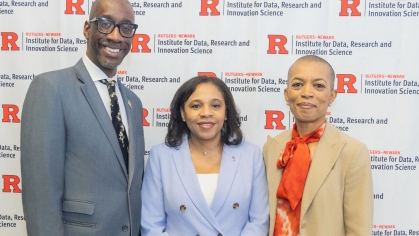RUBIC Strengthens Its Status as a Premier Regional Research Hub with New PRISMA Scanner
A new state-of-the-art brain-imaging scanner for advanced exploration into the workings of the human brain - a Siemens PRISMA functional magnetic resonance imaging (fMRI) scanner - will soon be available to researchers at the Rutgers University Brain Imaging Center (RUBIC) thanks to a National Science Foundation (NSF) grant in combination with matching funds from Rutgers University.
RUBIC’s new PRISMA instrument is key for the evolution of a regional center that will provide Rutgers with unique capabilities to better serve brain scientists from New Jersey, around the region and across the world in pursuing new lines of research at the cutting edge of this field.”
S. David Kimball
Senior Vice President for Research and Economic Development, Rutgers University
RUBIC has been evolving into a regional hub for advanced exploration into the workings of the human brain for a decade, drawing researchers to Rutgers–Newark from across the tri-state area. That status will be greatly enhanced as the center installs the new brain imaging scanner, which promises to significantly bolster its capacity and increase both the scope and quality of its research.
“The PRISMA is a much faster, higher-resolution, and more sophisticated scanner that is crucial to the sustainability and value of the center,” said RUBIC Director Stephen José Hanson, a professor in Rutgers–Newark's Department of Psychology. “We’ve reached saturation with the TRIO, making it impossible to keep up with research demand, and PIs [Principal Investigators] have been requesting more advanced imaging technology to push their work in new, innovative directions.”
The Siemens PRISMA fMRI scanner was made possible by a $1.6 million grant from the NSF plus additional funds from Rutgers-Newark’s Chancellor’s Office, its School of Arts and Sciences, and the university’s Office of Research and Economic Development. Arriving in August and ready by September 1, the scanner will provide a much-needed upgrade and complement to the Siemens TRIO scanner that RUBIC’s been using since its inception in 2010.
“RUBIC’s new PRISMA instrument is key for the evolution of a regional center that will provide Rutgers with unique capabilities to better serve brain scientists from New Jersey, around the region and across the world in pursuing new lines of research at the cutting edge of this field,” said S. David Kimball, Senior Vice President for Research and Economic Development at Rutgers. “Supporting this effort is a reflection of our commitment to enhancing our research infrastructure at Rutgers and enabling transformative and impactful research and science.”
PRISMA’s High-quality Scanning Capabilities
As RUBIC has grown in size and stature serving researchers throughout Rutgers, along with many outside the university, it has taken its place as a premier center for research in the subfields of cognitive, social and affective neuroscience, facilitating the study of everything from memory, decision-making and learning disabilities to traumatic injury and brain disorders such as Parkinson’s, Alzheimer’s and schizophrenia. The center has also led the way in human connectome research, or mapping the human brain, which involves looking not only at brain regions and networks, but also how they are recruited and influence one another, especially as pertains to learning disabilities, addiction and mental illness.
“The new PRISMA scanner is very fast, and that’s important because parts of the human brain communicate with one other extremely quickly, even when you do something simple like blink your eyes. The PRISMA will let us better track these fast messages and begin to understand what they're saying to enable perception, thought and action,” said Michael Cole, associate professor at the Center for Molecular and Behavioral Neuroscience at Rutgers–Newark and a co-PI on the PRISMA NSF grant. “It also will take clearer images of intersections and sharp turns in structural brain connections, enabling us to better map connectivity and ask more refined questions about how the brain functions.”
As a regional hub, RUBIC draws researchers from NJIT, New York University, Columbia University, Child Mind Institute, and Albert Einstein College of Medicine, to name a few. More than 150 PIs have used the facility since 2010, and over that time RUBIC has assisted in the acquisition and execution of nearly 60 federal and private-foundation grants totaling more than $35 million.
[The PRISMA] will take clearer images of intersections and sharp turns in structural brain connections, enabling us to better map connectivity and ask more refined questions about how the brain functions.
Michael Cole
Associate Professor, Center for Molecular and Behavioral Neuroscience, Rutgers–Newark
On average, 20-25 active PIs conduct research there annually, funded by federal and private-foundation grants. With the new PRISMA, Hanson intends to double the number of active PIs within one or two years, as use of the new scanner builds toward saturation, widening the center’s geographical reach to include researchers as far north as Connecticut and as far south as Philadelphia. And he expects a 20% increase in grant funding in the first year, followed by steeper increases thereafter.
“The PRISMA scanner alone increases the chances of NSF and NIH grant-funding significantly, since federal agencies want to fund cutting-edge research projects using the most advanced technology, and often the RFP will specify the use of a PRISMA,” added Hanson.
As the PRISMA helps RUBIC strengthen its active user-base and funding, it will also attract new faculty and further enhance an already robust community of researchers who gather at the facility, along with the publications that emerge from their work. In fact, data collected at RUBIC by both Rutgers and outside researchers has already contributed to large publicly available databases, highlighting the impact of RUBIC beyond the local scientific community. This will continue to grow as more researchers tap the potential of the new scanner.
RUBIC’s Enhanced Service and Reliability
According to Hanson, having the TRIO and PRISMA together will not only double scheduling capacity but also offer RUBIC researchers greater flexibility and cost-control, enabling them to use the TRIO for pilot research and switch to the PRISMA for later grants. The PRISMA also will expand and enrich training opportunities that RUBIC provides for graduate students from schools across the northeast, as well as Rutgers–Newark undergraduates, including underrepresented minority students.
RUBIC has always prided itself on being a full-service facility, providing not only high-quality scanning but also expert project advising and setup, along with data collection and storage. It’s a model of service and reliability that’s fostered a loyal user-base of researchers for a decade.
“Since the beginning, we’ve balanced the center’s business plan with research needs to provide high-quality service and a great user experience to the community, while keeping costs below revenue-avoiding deficits,” said Hanson. “We’ve been able to be self-sustaining as a result. It’s what sets us apart and has been key to our success, and we’ll rely on that model as we continue to grow with this new PRISMA scanner.”
Going forward, RUBIC will leverage that experience and expertise to help with Rutgers University’s new Center for Advanced Human Brain Imaging Research, which will also house a PRISMA when it comes online in 2021 on the Rutgers–New Brunswick campus. Meanwhile, RUBIC has state-of-the-art ventilation systems in many of its rooms and has put procedures and protocols in place in light of the pandemic to enable the facility to resume operations following a universitywide ramp down in research earlier this summer.
Adapted from story originally published by Lawrence Lerner, Rutgers-Newark


